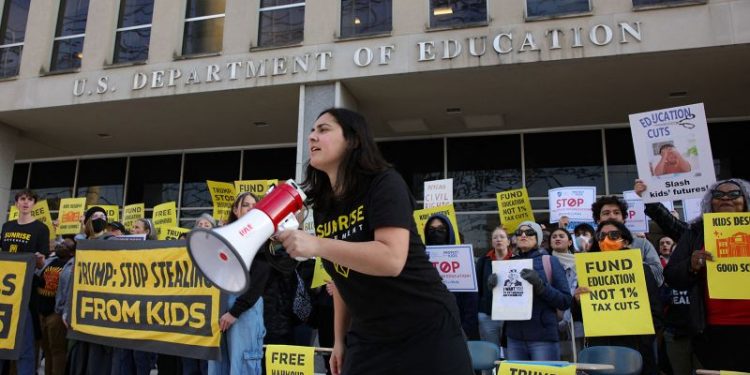Cnn
–
More than 275,000 layoffs were announced last month, reaching a level not seen since the pandemic, according to a new report published Thursday.
The biggest culprit was a particular employer: the federal government.
The federal government announced its intention of 216,215 jobs, representing almost 80% of 275,240 layoffs made by American employers in March, according to the latest Challenger Gray & Christmas report. It is the third highest monthly total behind April 2020 (671,129) and May 2020 (397,016).
The Government Ministry of Efficiency has managed a rude on the federal government, reduces funding, eliminating contracts and putting mass of federal workers.
“The job elimination announcements were dominated last month by (DOGE) plans to eliminate positions in the federal government,” said Andrew Challenger, Vice-President of the World Versian Society and Coaches. “It would have been a month old enough for dismissals.”
Of the remaining 59,025 discounts announced outside the federal government, the largest part was technology and retail, according to the report.
The announcements of March mark a jump of 60% compared to February, which saw a peak of itself, and they are up 205% compared to the 90,309 cuts announced in March 2024.
Doge -centered job cuts should not reach data from the labor market and the economy in one go. Although some federal employees have been dismissed immediately, others are serving a paid notice period in which they have essentially left, but will not be unemployed in weeks or even in months.
It is also important to note that the Challenger report had the intentions of layoff, which means that real job losses could occur in weeks or months (if they occur at all).
However, Doge’s drastic cuts should be strongly affected in local communities and the economy as a whole.
In February and March, 280,253 layoffs were described for federal workers and entrepreneurs in 27 agencies, according to the report. According to the report, 4,429 other job cuts (mainly affecting health care companies and non -profit organizations) took place due to the downstream effects of federal aid reduction or the end of contracts, according to the report.
“Cutting (public spending) without discrimination has no positive effect on an economy,” Gregory Daco, chief economist in Ey-Parthenon, told CNN in an interview. “Make the risks without discrimination and quickly having greater benefits for the private sector.”
“Move quickly and breaking things is a risky proposal,” he said.
In February, the American labor market has always appeared quite solid, but with cooler employment growth and a slowdown in labor turnover, the “unsubscribe” necessary for a healthy labor market.
Americans remain unemployed longer: the number of continuing unemployment insurance complaints, which are filed by Americans who have received at least one week or more from unemployed benefits, have been at the highest level since November 2021, according to data from the Labor Department published Thursday.
Continuous complaints increased from 56,000 to 1.9 million for the closed week on March 22, according to the Ministry of Labor report.
However, Thursday’s weekly report also showed that dismissal activity does not seem to be set up. Complaints for the first time for unemployment benefits fell to 219,000 last week, compared to 225,000 the previous week. Economists expected them to increase.
This overall number does not include federal workers (they are followed and recorded separately and reported with a week -long gap), although these affirmations have also decreased. During the week completed on March 22, 564 federal workers filed unemployment benefits. It is down compared to 821 the previous week, but well above the 371 which deposited during the week of the previous year.
The labor market in the United States has remained solid and stable for years now, offering a base for the very important consumer to remain afloat in high inflation and high interest rates.
Friday morning, the March Labor Statistics Publication of March Labor Statistics, could provide one of the clearest images to date on how the Radical Policy of the Trump administration goes back to trade, immigration and its redesigning redesign on the wider labor market.
This story has been updated with additional developments and context.


